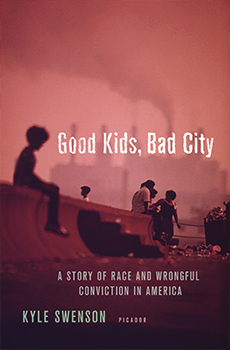Criminal Injustice
From Kenyon News - March 13, 2019
In 2011, Kyle Swenson ’07 was working as a reporter at the weekly alternative newspaper Cleveland Scene when he received a call from a paroled convict, Kwame Ajamu.
More than 30 years earlier, a teenage Ajamu (then known as Ronnie Bridgeman), his brother, Wiley Bridgeman, and his friend, Ricky Jackson, had been convicted of a gruesome murder on the east side of Cleveland. Ajamu maintained throughout that they had been unjustly accused and convicted. All three men had alibis, and the sole witness to the event was a 12-year-old boy whose story contained large inconsistencies.
As Swenson investigated the case, he believed Ajamu was telling the truth. A story he wrote in 2011 eventually helped lead to Jackson and Wiley Bridgeman’s release from prison in 2014. It was the longest wrongful imprisonment in the country to end in exoneration; at that point, Jackson had spent 39 years in jail.

Since 2017, Swenson has worked for The Washington Post, and has expanded his investigation into a book, “Good Kids, Bad City: A Story of Race and Wrongful Conviction in America,” which was released last month. We spoke with Swenson, an English major at Kenyon, about how the case has changed his own views on social justice, Kenyon’s influence on his career and more.
What did you think when you first met Kwame Ajamu? Did you instinctively have a sense of his credibility?
We met at a Starbucks downtown. He had this big box of documents on the table with him. For a reporter, that kind of sets your heart fluttering because you know there’s some actual legal documentation behind the story. I thought he was really credible. It didn’t seem like he was trying to sell me on story; he wasn’t desperate to have me believe him. He just laid out the facts of the case and said very clearly, “this is what happened to us.”
Your original article, “What The Boy Saw,” which laid out the inconsistencies of the 12-year-old’s testimonies and quoted from neighborhood members who had never been questioned by the police previously, was published in June of 2011. What did you think would happen after it went to press?
I had hoped that when this article hit the boxes it would spark this general outrage. I really thought that judges would immediately snap into action and these guys would be freed and that justice would be acknowledged. So when the story came out and nothing happened, it was really frustrating.
But unbeknownst to me at the time, the reporting actually really began the wheels turning at the Ohio Innocence Project, which led to Ricky’s exoneration years later.
Right, your article inspired lawyers at the Ohio Innocence Project — a project out of the University of Cincinnati Law School that works on exoneration cases — to pick up Ricky’s file again. They were later able to locate the main witness from the trial, who recanted his testimony. What was it like, sitting in the courtroom, in 2014, when the charges against Ricky were dropped?
It was incredible. It felt like the world had been turned upside down — particularly because I had asked one of the attorneys from the Ohio Innocence Project that day about what would happen. He said, “Well, the judge will take the hearing back and in a couple weeks, he’ll issue a written order and then we’ll know.” So I was like, “Okay, this isn’t going to be resolved today.” And he was like, “No, this is not the movies.”
So it was completely incredibly shocking in a great way to get to see Ricky released that day.
How did you decide to turn the story into a book?
After the exonerations, I wrote a follow-up for Scene. But even after I was done, I knew that there were things I wasn’t able to get into. I began thinking about this as a book project — that this could be a way to tell the larger story of Cleveland, and criminal justice in America.
How did your Kenyon education help inform your sense of social justice?
When I started at Kenyon, I was a progressive, young college student. I thought I had all the right opinions about race and social justice. But then there was this moment in Professor Perry Lentz’s American literature class that really had a profound impact on my life.
We were reading “The Adventures of Huckleberry Finn” and had to write an essay where we follow the story arc of one character. After the assignment, Professor Lentz pointed out that none of us in the whole class had thought about how, at the end of the book, Tom Sawyer knows that Jim (a runaway black slave who has been imprisoned) has been set free, but he lets Jim continue to think he’ll be shipped back into slavery, while he goes on an adventure with Huck. It was really kind of sick — and yet none of us in this group of seemingly progressive right-minded students had even noted it. It really showed us our blind spots. Professor Lentz showed us that racism isn’t just institutional. It is also a lack of empathy. That lesson has really stayed with me as a journalist.
This interview has been edited for length and clarity.